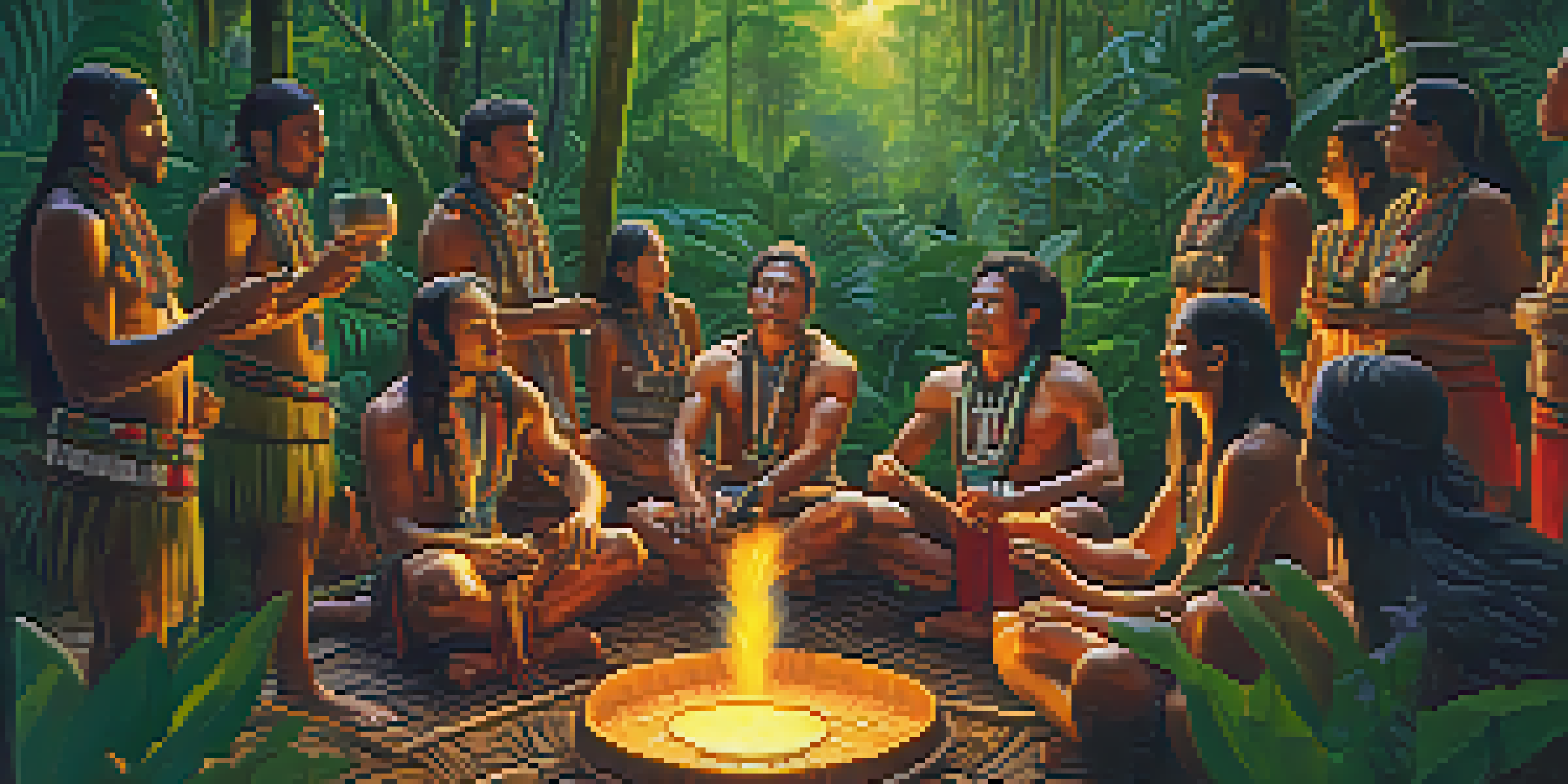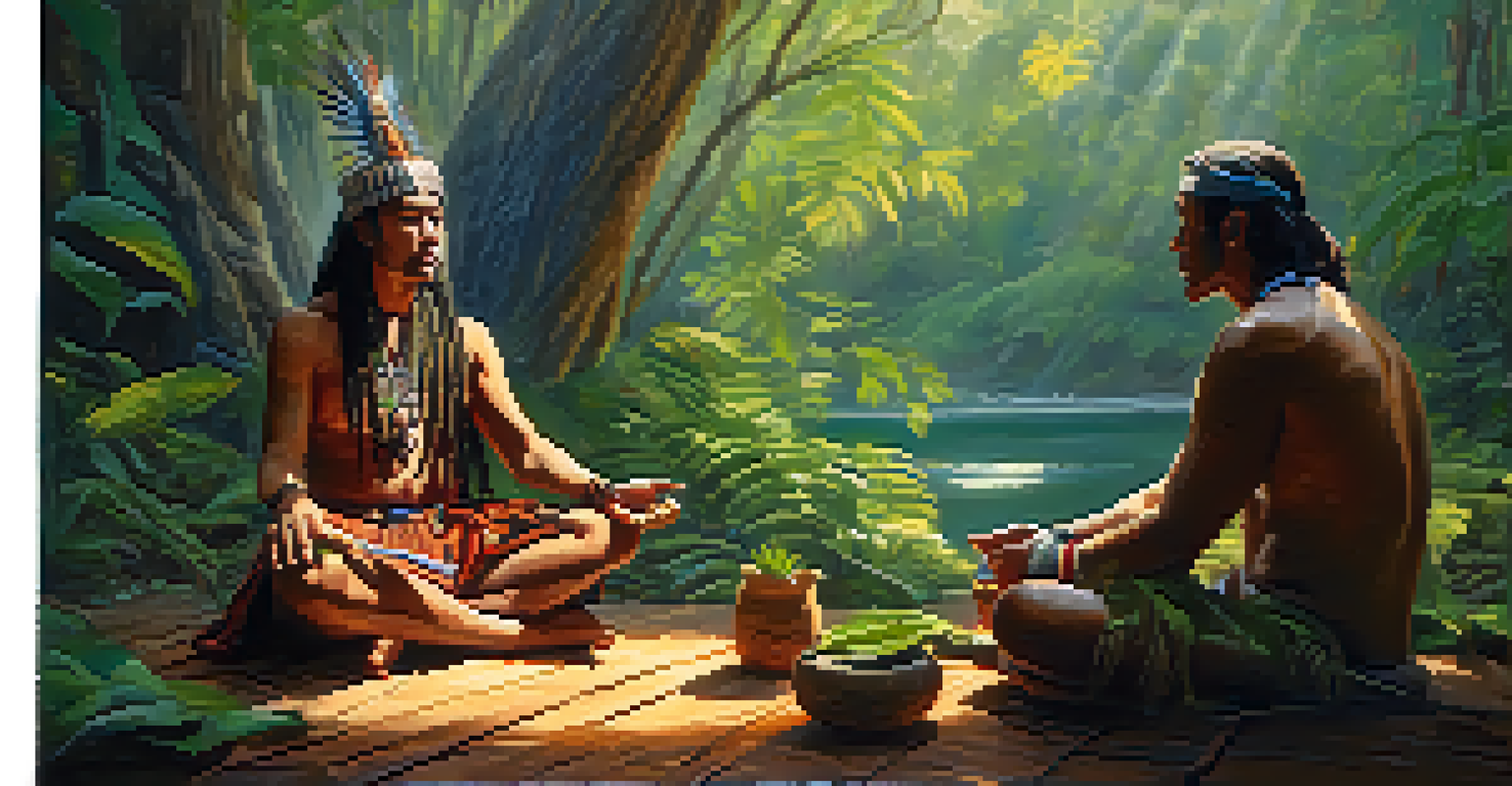The Role of Shamans in Ayahuasca Ceremonies and Practices

Shamans: The Spiritual Guides of Ayahuasca Ceremonies
In ayahuasca ceremonies, shamans serve as spiritual guides, helping participants navigate their journeys. Their role is crucial, as they possess deep knowledge of the plant medicine and its effects, ensuring a safe and meaningful experience. Often called 'curanderos' or 'curanderas', these practitioners are revered within their communities for their wisdom and healing abilities.
The shaman is the one who has the ability to connect with the spiritual world, bridging the gap between the seen and the unseen.
The shaman's connection to the spiritual realm is believed to facilitate communication between the participants and the medicine. This connection allows them to interpret visions and feelings that arise during the ceremony, providing insights that can lead to profound personal revelations. By creating a safe space, shamans encourage participants to explore their inner selves without fear.
Moreover, shamans often use traditional songs, or 'icaros', to guide the ceremony. These songs are thought to have healing properties, helping to channel the energies and intentions of the participants. Through their chants and rituals, shamans set the tone for the experience, promoting a sense of community and shared purpose.
The Preparation: Setting Intentions with Shamans
Before the ceremony begins, shamans often meet with participants to discuss their intentions. This preparatory conversation is vital, as it helps the shaman understand what each individual hopes to achieve from the experience. Whether it's healing, clarity, or personal growth, setting clear intentions can significantly enhance the journey.

During these discussions, shamans may share their insights or advice based on their experiences with ayahuasca. They might suggest focusing on specific issues or emotions that the participant wishes to confront. This collaborative approach helps build trust and rapport between the shaman and the participants, creating a supportive atmosphere.
Shamans Guide Ayahuasca Journeys
Shamans serve as spiritual guides in ayahuasca ceremonies, using their knowledge and connection to the spiritual realm to facilitate participants' transformative experiences.
Ultimately, the intention-setting process is about co-creation, where the shaman and participant work together to align their energies. This alignment helps to ensure that the experience is not only transformative but also deeply personal and meaningful.
Navigating the Journey: The Shaman's Role During the Ceremony
As the ayahuasca takes effect, the shaman's role shifts to that of a facilitator. They monitor the participants' experiences, providing guidance and support as needed. This involves observing the physical and emotional states of those present, ensuring their safety while also encouraging them to confront their challenges.
Healing is not just about what happens in a ceremony, but how we integrate those experiences into our daily lives.
Throughout the ceremony, the shaman may sing icaros, which serve to anchor participants in their journey. These songs are more than mere melodies; they carry specific intentions and energies that can help guide individuals through their experiences. The shaman’s voice can be a source of comfort, helping to soothe fears and reinforce positive emotions.
Additionally, the shaman often employs traditional instruments, such as drums or rattles, to enhance the ceremonial atmosphere. These sounds create a rhythmic backdrop that can help participants enter deeper states of consciousness, facilitating connection with the medicine and their inner selves.
Healing and Integration: Shamans as Counselors
After the ceremony, the shaman often plays a crucial role in the integration process. This phase is essential for making sense of the insights gained during the journey. Shamans provide counseling, helping participants process their experiences and apply the lessons learned to their daily lives.
Integration can include follow-up discussions where shamans encourage individuals to share their experiences, emotions, and realizations. This dialogue helps participants articulate and understand their journeys, fostering a deeper connection to their insights. The shaman's guidance during this phase can significantly influence how participants carry their experiences forward.
Intentions Shape Ceremony Outcomes
Setting clear intentions with shamans before the ceremony enhances personal growth and ensures a meaningful journey.
Moreover, shamans may offer additional rituals or practices to support ongoing healing and transformation. By providing tools for integration, they empower participants to continue their personal growth beyond the ceremony, reinforcing the notion that healing is a continuous journey.
Cultural Significance: Shamans and Indigenous Traditions
Shamans hold an important place in indigenous cultures, particularly in regions where ayahuasca is traditionally used. Their practices are often steeped in centuries of wisdom and cultural heritage, making them custodians of ancient knowledge. This deep-rooted connection to the land and its plants enhances the authenticity of their healing work.
Additionally, shamans often serve as community leaders, addressing not only individual healing but also collective well-being. They play a vital role in maintaining the cultural identity and spiritual practices of their communities, ensuring that these traditions are preserved for future generations.
The respect and reverence afforded to shamans reflect their integral role in the fabric of indigenous life, emphasizing the importance of cultural context in ayahuasca ceremonies. This cultural lens enriches the experience, reminding participants of the deep connections between healing, nature, and community.
Challenges and Misunderstandings of Shamanic Practices
Despite their significance, the role of shamans is often misunderstood in modern contexts, particularly in the West. Some may view shamans merely as facilitators of a psychedelic experience, overlooking the depth of their spiritual and cultural responsibilities. This misunderstanding can lead to a commodification of their practices, stripping away the sacredness of the ceremonies.
Moreover, the influx of tourists seeking ayahuasca experiences can create challenges for shamans and their communities. The demand for ceremonies may lead to the emergence of untrained individuals claiming to be shamans, which can jeopardize the safety and integrity of the experience. This highlights the importance of seeking authentic, culturally grounded practitioners.
Integration is Key After Ceremony
The shaman's role extends beyond the ceremony, providing essential support and guidance for participants to integrate their insights into everyday life.
Education and respectful engagement with indigenous cultures are essential in bridging these gaps. By promoting understanding of the shaman's role and the cultural significance of their work, participants can approach ayahuasca ceremonies with the respect and openness they deserve.
The Future of Shamanism in Ayahuasca Practices
As interest in ayahuasca continues to grow globally, the future of shamanism faces both challenges and opportunities. The increasing popularity of ayahuasca has led to a greater awareness of its benefits, but it has also raised concerns about cultural appropriation and the dilution of traditional practices. It's crucial to navigate this landscape with sensitivity and respect for indigenous traditions.
Shamans may find themselves at the forefront of a movement that bridges traditional healing with contemporary wellness practices. By sharing their knowledge and experiences, they can educate participants about the cultural significance of their work while fostering a deeper understanding of the ayahuasca experience.

Ultimately, the future of shamanism in ayahuasca practices relies on mutual respect, collaboration, and ongoing dialogue. By honoring the roots of these ceremonies and the wisdom of shamans, we can ensure that their invaluable contributions to healing and spirituality are preserved and celebrated.